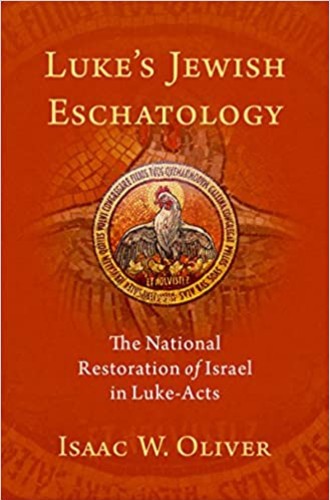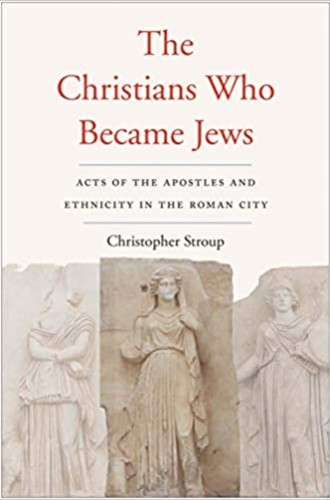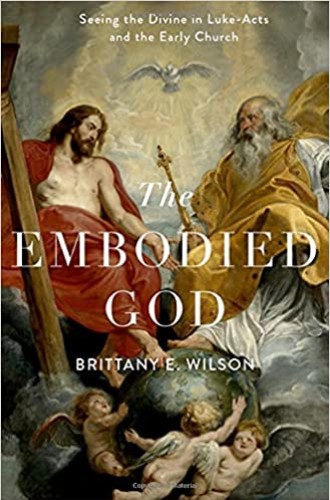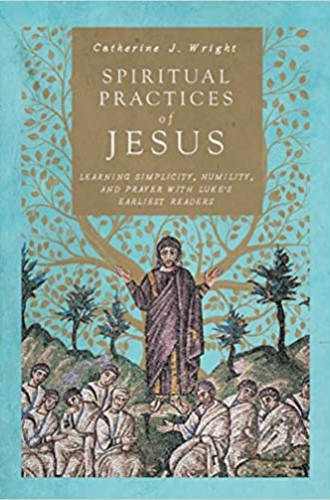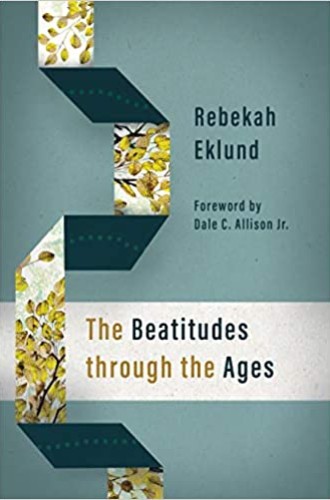The Gospel of Luke and the Acts of the Apostles have enjoyed something of a resurgence in recent New Testament research. One of the ongoing challenges raised by Luke-Acts is discerning the relationship between Judaism and Christianity. The history of reception is filled with those who read Acts as representing the view that gentile Christians have displaced Israel as the people elected by God and that there is no hope for the salvation and final restoration of the Jewish people. Isaac Oliver, in Luke’s Jewish Eschatology: The National Restoration of Israel in Luke-Acts (Oxford University Press), shows just how wrongheaded these readings of Luke-Acts are.
Oliver demonstrates how the hopes for Israel’s national restoration and salvation are raised in Luke’s infancy narrative and fulfilled in part, albeit in a surprising way, through God’s resurrection of Jesus as the Davidic Messiah. Nothing in Luke-Acts indicates that the anticipation for Israel’s restoration is overridden by unbelief, transferred to another people, or spiritualized. Although Jesus weeps over Jerusalem’s rejection of his message and delivers prophetic warnings, he is also frequently depicted as having an ongoing affectionate response to Jerusalem. While the Jewish people are by no means unified in their response to Paul’s gospel, Oliver argues that Luke maintains an eschatological expectation that God will intervene to extend full national salvation to Israel despite its momentary resistance to the gospel. Oliver doesn’t ask his readers to accept Luke’s vision, but he clearly shows that Luke-Acts never gives up hope for the Jewish people.
Read our latest issue or browse back issues.
From a very different angle, Christopher Stroup also explores the relationship between Jewishness and Christian origins in Acts. The Christians Who Became Jews: Acts of the Apostles and Ethnicity in the Roman City (Yale University Press) utilizes archaeological and material constructions that memorialize ethnic and civic identities in ancient Roman cities to argue that Acts depicts Jewish ethnicity as variegated and hybrid. Acts engages in a form of ethnic reasoning to demonstrate how being a follower of Jesus is an appropriate and better way of being Jewish, Stroup argues.
Luke’s first use of the term Jew/Judean (Ioudaios) in Acts 2:5–13 shows that Jewish identity is hybrid and flexible. That is, one can be ethnically Jewish and Parthian, Median, Egyptian, or even a “non-Jewish Jewish proselyte.” Jewish identity can be passed on through one’s lineage, or it can be achieved through the observance of ancestral customs. Stroup compares Acts with the Salutaris Foundation—an inscription memorializing how a wealthy benefactor forged links between Artemis, Ephesus, and Rome—to show how Luke used religious imagery, the flexibility of ethnic reasoning, and the concept of an authoritative council to “integrate Christian non-Jews into the Jewish community as a type of proselyte Jew.” Stroup’s argument challenges those who fail to see early Christian identity as inclusive of ethnic identity.
One of the most contentious differences between early Jews and Christians concerned the relationship between Jesus and the God of Israel. Recent research has suggested that many Jewish texts portray God as, at times, visible and even embodied. In The Embodied God: Seeing the Divine in Luke-Acts and the Early Church (Oxford University Press), Brittany E. Wilson offers a powerful reading of Luke-Acts as portraying a visible and corporeal God, especially in God’s relationship to Jesus’ human flesh.
The dominance of Platonic-Christian metaphysics has often prevented exegetes from recognizing how visible the God of Luke-Acts is. Sight is frequently emphasized in the Lukan Transfiguration account (Luke 9:28–36) and the resurrected Jesus’ epiphanic appearance on the Emmaus Road (24:13–35) as one of the ways in which people experience Jesus as divine revelatory light. In fact, Luke uses the literary trope of a theoxeny (divine visitation) to portray Jesus’ life as an epiphany. After Jesus’ ascension into heaven, Acts narrates multiple Christophanies whereby Christ propels the divine will forward as he visibly appears to people through dreams and visions. Given the complexity of speaking about God and divine revelation, Wilson suggests that Luke-Acts exemplifies biblical wrestling with the paradoxical tension between God’s presence and hiddenness, God’s knowability and unknowability.
The Lukan writings have also provided resources for the pursuit of character formation, spiritual practices, and ethical insights. Catherine J. Wright’s Spiritual Practices of Jesus: Learning Simplicity, Humility, and Prayer with Luke’s Earliest Readers (InterVarsity Press) examines how Luke’s Jesus is the supremely good king and teacher who calls his people to a distinctive way of life. In fact, Luke’s ideal readers are those who want to be transformed by Jesus’ teachings and practices, specifically the practices of simplicity, humility, and prayer.
Wright illuminates each of Jesus’ spiritual practices with a three-pronged approach: studying each practice within the Gospel narrative, comparing it with prevalent first-century cultural ideals, and tracing the influence of the Lukan texts in the writings of the church fathers. For example, the Lukan Jesus consistently teaches the necessity of humility as a practice that rejects quests for status, honor, and power at the expense of others. This teaching likely sat well alongside the cultural critiques of philosophical moralists (such as Epictetus, Plutarch, and Lucian) who disdained the imperial penchant to accrue undeserved glories as well as those who engaged in excessive self-praise. Wright then draws upon the wisdom of church fathers (such as Ambrose, John Chrysostom, and Cyril of Alexandria) to show how Jesus’ teachings on humility were used to emphasize the absolute necessity of humility for all Christians. This was important in a context where pride, especially pride in one’s own spiritual progress, was considered directly antithetical to Jesus’ teaching and character.
The Beatitudes through the Ages (Eerdmans) also attends to the vast reception history of Jesus’ teachings, focusing on Matthew’s and Luke’s Beatitudes. Rebekah Eklund shows how the voices of past readers can challenge biases, reveal unnoticed aspects of the text, and nurture love for God and neighbor. For example, Jesus’ blessing upon the poor (Luke 6:20) and the poor in spirit (Matt. 5:3) have challenged readers to think about humility and poverty. Many premodern and Reformation interpreters understood poverty of spirit as akin to dependence upon God; others, such as Tertullian, understood Jesus to be pronouncing a blessing upon those who embrace material poverty. More recently, Elsa Támez has suggested that this blessing is not meant to extol the goodness of poverty; rather, the poor are blessed precisely because God’s eschatological justice is imminent—and with it will come the eradication of poverty.
Until the Reformation, Jesus’ blessing upon those who mourn or are sorrowful was almost universally interpreted as a blessing upon those who are grieved over their own sin. The view began to shift with Martin Luther and John Calvin, who suggested that the mourning here refers to the difficult trials of ordinary human existence. An emphasis on material conditions as the context for grief appears among more recent readers who draw upon this Beatitude to address divisions in the church, structural sin and injustice, and weeping with those who weep. Eklund’s book offers a fascinating window into the hermeneutical relationship between texts and social contexts, reminding readers that the words of the New Testament have shaped and transformed human lives in different ways.
Read Susan Willhauck's practical theology selections, Philip Jenkins's global Christianity selections, and Anne Blue Wills's American religious history selections.
A version of this article appears in the print edition under the title “Take & Read: New Testament.”


